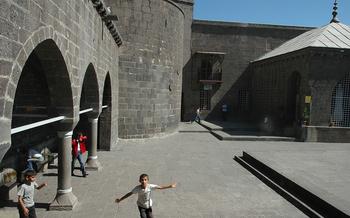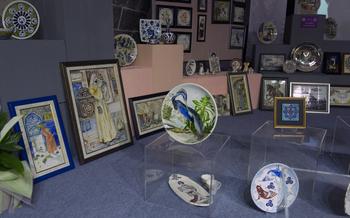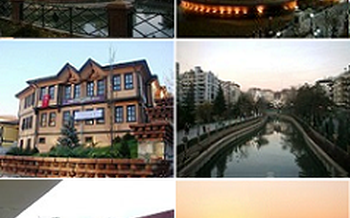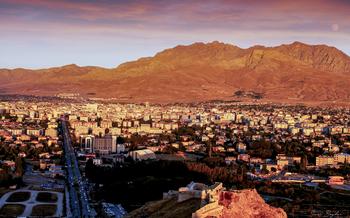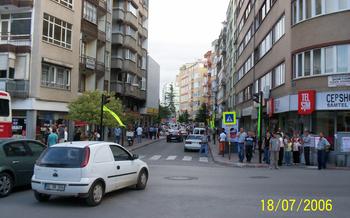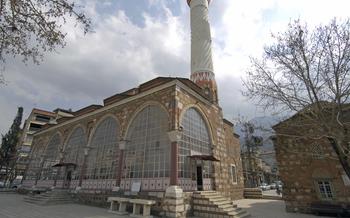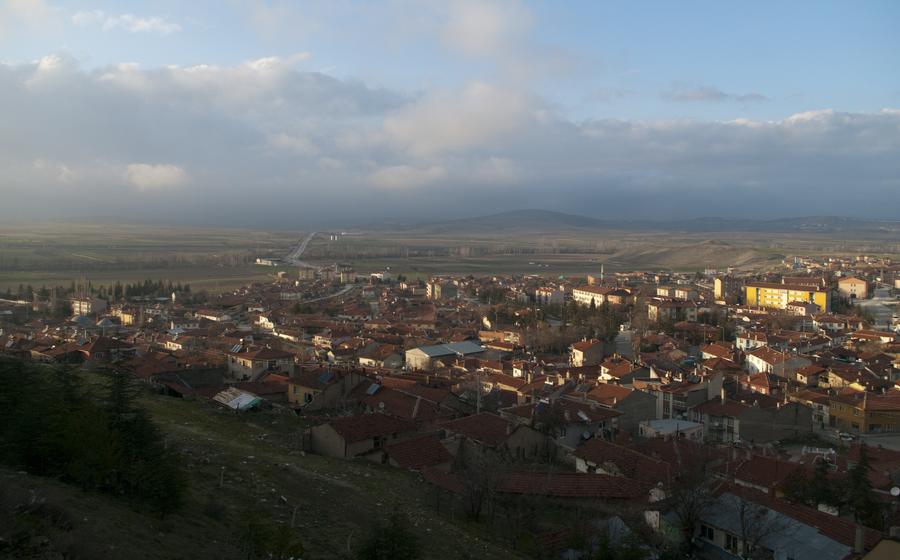
Seyitgazi Tomb
- The Seyitgazi Tomb: A Historical Gem
- Historical significance
- Architectural features
- Cultural importance
- Location and accessibility
- Unveiling the History of Seyitgazi
- A Journey Through Time: The Tomb's Interior
- The Significance of the Seyitgazi Tomb
- A Place of Pilgrimage and Spiritual Connection
- The Seyitgazi Tomb Complex
- A Symbol of Resilience: The Tomb's Restoration
- Visiting the Seyitgazi Tomb: Practical Information
- Unforgettable Moments: Personal Anecdotes
- Capturing the Essence: Photography Tips
- Delving Deeper: Recommended Reading
- Events and Festivals: Celebrating Seyitgazi's Legacy
- Exploring Eskişehir: Beyond the Tomb
- Insider Tip: Unveiling Hidden Secrets
The Seyitgazi Tomb: A Historical Gem
Nestled in the heart of Eskişehir, Turkey, the Seyitgazi Tomb stands as a testament to the rich history, architectural prowess, and cultural significance of the region. Built in the 14th century, the tomb is not just a historical site but a masterpiece of Islamic architecture that has captured the admiration of visitors for centuries.
Historical significance
The Seyitgazi Tomb holds a prominent place in Turkish history, serving as the final resting place of Seyitgazi, a revered figure in both religious and military circles. As a descendant of the Prophet Muhammad, Seyitgazi played a pivotal role in the Ottoman Empire's expansion, leading armies to victory in numerous battles. His tomb has become a symbol of his legacy, drawing pilgrims and history enthusiasts alike.
Architectural features
The Seyitgazi Tomb is a striking example of Seljuk architecture, showcasing intricate carvings, geometric patterns, and elegant calligraphy. The tomb's exterior is adorned with decorative tiles and muqarnas, creating a mesmerizing visual spectacle. Inside, the tomb features a domed ceiling, elaborately painted walls, and exquisite calligraphy inscriptions that evoke a sense of awe and reverence.
Cultural importance
The Seyitgazi Tomb holds immense cultural significance for the people of Eskişehir and Turkey as a whole. It serves as a place of pilgrimage for Muslims, who come to pay their respects to Seyitgazi and seek blessings. The tomb is also a source of inspiration for artists and writers, who find in its beauty and history a muse for their creative endeavors.
Location and accessibility
The Seyitgazi Tomb is conveniently located in the city center of Eskişehir, making it easily accessible for visitors. It is situated within a tranquil garden, providing a serene and contemplative atmosphere for those who wish to explore its historical and cultural significance.
Unveiling the History of Seyitgazi
Seyitgazi was a revered figure in the Ottoman Empire, known for his wisdom, bravery, and spiritual guidance. Born in the 13th century, he played a significant role in the expansion and consolidation of the Ottoman state. As a military leader, he fought alongside Osman I, the founder of the empire, and contributed to the conquest of many territories.
His spiritual influence was equally profound. Seyitgazi was a Sufi mystic and a teacher who preached love, tolerance, and unity among people. He established a dervish lodge in Eskişehir and attracted a large following of disciples who sought his guidance and teachings.
Over time, Seyitgazi became a symbol of wisdom, justice, and compassion. Legends and myths surrounding his life and miracles spread throughout the region, further enhancing his reputation as a holy man. His legacy lived on in Eskişehir, where he was deeply respected and revered by the local population.
A Journey Through Time: The Tomb's Interior
As you step inside the Seyitgazi Tomb, you are greeted by an intricate and awe-inspiring interior design. The ceiling is adorned with exquisite decorations and wall paintings that narrate stories from history and mythology. The walls are adorned with calligraphy and tilework, each stroke and tile meticulously placed to create a harmonious and visually stunning composition.
The tomb is also home to a collection of historical artifacts and relics, including personal belongings of Seyitgazi and other important figures from the Ottoman period. These artifacts offer a tangible connection to the past and provide valuable insights into the life and times of Seyitgazi and his contemporaries.
Among the highlights of the tomb's interior are the intricately carved wooden doors, which feature intricate geometric patterns and calligraphy. The mihrab, or prayer niche, is another masterpiece, adorned with colorful tiles and intricate carvings that showcase the skill and artistry of the craftsmen who created this magnificent structure.
The Significance of the Seyitgazi Tomb
The Seyitgazi Tomb holds immense religious, political, and social significance in Eskişehir and beyond. Its religious importance stems from its association with Seyitgazi, a revered figure in Islamic history. The tomb is considered a sacred site and a place of pilgrimage for Muslims, who come to pay their respects and seek blessings.
Politically, the tomb symbolizes the Ottoman Empire's influence and power in the region. Seyitgazi's role as a military leader and his close ties to the Ottoman sultans made the tomb a symbol of the empire's authority and prestige. It served as a reminder of the Ottoman dynasty's commitment to Islam and its patronage of religious figures.
Socially, the tomb represents unity and cultural harmony in Eskişehir. Seyitgazi was known for his tolerance and respect for people of different faiths and backgrounds. His tomb, therefore, became a symbol of peaceful coexistence and understanding among various communities in the city. It fostered a sense of shared heritage and encouraged people to work together for the common good.
The Seyitgazi Tomb also serves as a source of inspiration for artists, writers, and historians. Its architectural beauty, historical significance, and spiritual aura have captured the imagination of creative minds for centuries. Numerous poems, paintings, and stories have been inspired by the tomb, contributing to its enduring legacy as a cultural landmark.
A Place of Pilgrimage and Spiritual Connection
The Seyitgazi Tomb holds immense religious significance, attracting pilgrims and visitors from far and wide. The tomb is considered a sacred site, where devotees come to seek blessings, pay their respects, and connect with the spiritual legacy of Seyitgazi.
Rituals and ceremonies are frequently held at the tomb, honoring Seyitgazi's memory and perpetuating his teachings. Dervishes and Sufi mystics play a pivotal role in these ceremonies, reciting prayers, performing zikr (remembrance of God), and sharing stories of Seyitgazi's life and miracles.
Many visitors report a sense of peace and tranquility within the tomb, attributing it to the spiritual energy that permeates the space. Stories of miracles and blessings abound, further enhancing the tomb's reputation as a site of spiritual connection and divine intervention.
The tomb's sacred aura attracts people from all walks of life, creating a unique atmosphere of unity and harmony. Despite their diverse backgrounds and beliefs, visitors come together to honor Seyitgazi's legacy and seek spiritual guidance and solace within the tomb's hallowed walls.
The Seyitgazi Tomb Complex
The Seyitgazi Tomb is not just a standalone structure; it is part of a larger complex that includes several other buildings and structures. These elements collectively contribute to the tomb's significance and provide a glimpse into the social and religious life of the Ottoman era.
Surrounding the tomb is a beautiful courtyard adorned with gardens and trees, creating a serene and contemplative atmosphere. The courtyard serves as a gathering place for visitors, a venue for religious ceremonies, and a space for relaxation and reflection.
The complex also includes a mosque, a madrasah (Islamic school), and an imaret (soup kitchen). The mosque, with its elegant minaret, is a place of worship for both locals and pilgrims. The madrasah, once a center of Islamic learning, provided education in religious studies and other subjects. The imaret, a charitable institution, offered food and shelter to the needy, demonstrating the tomb's commitment to social welfare.
Together, these structures form a cohesive ensemble that showcases the tomb's multifaceted role as a religious, educational, and social center. They offer visitors a deeper understanding of the Ottoman Empire's architectural heritage and its emphasis on community and social responsibility.
A Symbol of Resilience: The Tomb's Restoration
The Seyitgazi Tomb, a testament to history and architectural prowess, faced the inevitable ravages of time. Wear and tear, coupled with the relentless passage of centuries, left their mark on the once-majestic structure. The tomb's deterioration was a cause for concern, not just for the people of Eskişehir but for history enthusiasts worldwide.
In response to the tomb's declining condition, a comprehensive restoration project was meticulously planned and executed. Experts in architecture, history, and conservation came together to breathe new life into this iconic landmark. The restoration process involved careful examination, documentation, and meticulous repairs, ensuring that the tomb's original features were preserved while addressing structural issues.
The restoration team faced several challenges along the way. The tomb's intricate carvings and delicate inscriptions required specialized techniques to ensure their preservation. Balancing the need for structural reinforcement with the retention of historical authenticity was a delicate task. Moreover, the project had to navigate the complexities of funding and securing the necessary permits.
Despite the obstacles, the restoration process was a resounding success. The Seyitgazi Tomb emerged as a revitalized symbol of resilience, its grandeur and beauty restored. This remarkable transformation stands as a testament to the dedication and expertise of the individuals involved, ensuring that the tomb's legacy will continue to inspire and captivate generations to come.
Visiting the Seyitgazi Tomb: Practical Information
To fully immerse yourself in the history and spirituality of the Seyitgazi Tomb, planning your visit is crucial. Opening hours are generally from 9 am to 5 pm daily, allowing ample time to explore the tomb and its surroundings. While admission is free, donations are welcome to support the tomb's upkeep and preservation.
Dress code and etiquette should be observed when visiting the tomb, as it is a sacred site. Modest attire that covers shoulders and knees is recommended, and visitors should refrain from loud noises or disrespectful behavior.
Guided tours are available for a deeper understanding of the tomb's history and significance. These tours, often led by knowledgeable guides, provide insights into the tomb's architectural features, religious symbolism, and the life of Seyitgazi himself.
Audio guides are another option for self-guided exploration. These devices offer detailed information about the tomb's various sections, allowing visitors to learn at their own pace.
Facilities for visitors are available on-site to enhance your experience. Ample parking is provided, ensuring convenient access to the tomb. Restrooms are also available for visitor convenience.
Unforgettable Moments: Personal Anecdotes
My first encounter with the Seyitgazi Tomb was during a spontaneous road trip across Turkey. As I wandered through the streets of Eskişehir, I stumbled upon this hidden gem tucked away in a quiet neighborhood. The imposing structure immediately captivated me, and I stepped inside to explore its sacred halls.
As I walked through the tomb's interior, I was transported to another era. The intricate tilework, the vibrant wall paintings, and the ornate carvings whispered stories of a rich history. I couldn't help but feel a sense of awe and reverence as I stood in the presence of such a magnificent work of art.
During my visit, I had the privilege of meeting a local guide who shared fascinating stories and legends about Seyitgazi. I learned about his heroic deeds, his spiritual teachings, and the profound impact he had on the people of Eskişehir. The guide's passion for this historical figure was contagious, and I left the tomb with a newfound appreciation for Seyitgazi's legacy.
One particularly memorable moment during my visit was when I witnessed a group of dervishes performing a traditional Sufi ritual inside the tomb. The rhythmic chanting, the graceful movements, and the soulful music created a captivating atmosphere that transported me to a realm of spirituality and serenity. It was an experience that left an indelible mark on my soul.
Whether you're a history buff, a spiritual seeker, or simply a curious traveler, visiting the Seyitgazi Tomb is sure to leave you with unforgettable memories. It's a place where the past and present intertwine, where history comes alive, and where the spirit of Seyitgazi continues to inspire and guide those who seek his blessings.
Capturing the Essence: Photography Tips
To fully capture the essence of the Seyitgazi Tomb through photography, timing and technique are key. The ideal lighting conditions are during the golden hours, just after sunrise or before sunset, when the warm light casts a magical glow on the tomb's intricate details. For optimal results, use a wide-angle lens to showcase the tomb's grandeur, ensuring that the entire structure fits within the frame. Experiment with different compositions, capturing the tomb from various angles to highlight its unique features and surroundings. To capture the tomb's intricate carvings and inscriptions, get up close and use a macro lens to reveal the fine craftsmanship and hidden meanings. With patience and creativity, you can create stunning photographs that encapsulate the beauty and significance of the Seyitgazi Tomb.
Delving Deeper: Recommended Reading
To further immerse yourself in the history and significance of the Seyitgazi Tomb, consider delving into a selection of recommended readings. These books, articles, and online resources offer a wealth of information, from historical accounts and research papers to literary works inspired by the tomb's captivating aura.
For a comprehensive overview of the tomb's history, architecture, and cultural significance, refer to the book "The Seyitgazi Tomb: A Historical and Architectural Gem" by renowned historian Dr. Mehmet Akif Ersoy. This well-researched volume provides detailed insights into the tomb's construction, its role in the Ottoman Empire, and its enduring legacy.
To delve deeper into the fascinating life of Seyitgazi himself, explore the historical novel "The Dervish of Eskişehir" by acclaimed author Elif Shafak. This captivating tale brings to life the adventures and struggles of Seyitgazi as he navigates the tumultuous political and social landscape of the 16th century.
For those seeking a more academic perspective, the journal article "The Seyitgazi Tomb: A Case Study in Ottoman Architecture" by Professor Ayşe Gül Altıntaş offers an in-depth analysis of the tomb's architectural features, symbolism, and its place within the broader context of Islamic architecture.
Numerous online resources and websites also provide valuable information about the Seyitgazi Tomb. The official website of the Eskişehir Museum (www.eskisehirmuzesi.gov.tr) features a dedicated section on the tomb, showcasing its history, architectural details, and visiting information.
By exploring these recommended readings, you will gain a deeper understanding and appreciation for the Seyitgazi Tomb, its historical significance, and its enduring impact on the cultural landscape of Turkey.
Events and Festivals: Celebrating Seyitgazi's Legacy
Eskişehir comes alive during the annual festivals and events held at the Seyitgazi Tomb. These celebrations honor the life and legacy of Seyitgazi, bringing together locals and visitors in a vibrant display of cultural heritage.
The most prominent event is the Seyitgazi Commemoration Festival, held every year in May. This grand festival features traditional performances, music concerts, and Sufi whirling dervish ceremonies. Visitors can immerse themselves in the rich cultural traditions of the region and witness the deep reverence for Seyitgazi.
Throughout the year, various other events and festivals take place at the tomb complex. These include religious ceremonies, poetry recitals, and exhibitions showcasing local art and handicrafts. Visitors are encouraged to participate in these events to gain a deeper understanding of Seyitgazi's impact on the community and the enduring legacy of his teachings.
Exploring Eskişehir: Beyond the Tomb
While the Seyitgazi Tomb stands as a prominent landmark in Eskişehir, the city offers a wealth of other attractions and experiences for visitors to discover. History buffs can delve into the past at the Eskişehir Archaeological Museum, showcasing artifacts from the region's rich history. Art enthusiasts can admire the impressive collection of modern and contemporary artworks at the Eskişehir Museum of Modern Art.
Nature lovers can explore the stunning Porsuk River, which meanders through the city, offering picturesque views and opportunities for leisurely strolls or boat rides. For those seeking outdoor adventures, the nearby Mount Süphan National Park provides a breathtaking landscape for hiking, camping, and wildlife spotting.
Eskişehir's culinary scene is not to be missed. Visitors can savor the flavors of traditional Turkish cuisine at local restaurants, indulge in delectable pastries at charming cafes, or sip on refreshing beverages at vibrant bars. The city's vibrant atmosphere is further enhanced by its lively nightlife, with a variety of entertainment options to suit every taste.
From historical landmarks to natural wonders, cultural attractions to culinary delights, Eskişehir offers a captivating blend of experiences for travelers seeking to explore beyond the Seyitgazi Tomb.
Insider Tip: Unveiling Hidden Secrets
As you explore the Seyitgazi Tomb, keep an eye out for its hidden gems. Ask your guide about secret passages or hidden chambers that may not be immediately visible. These hidden spaces often reveal intriguing stories and offer unique perspectives on the tomb's history and significance.
One lesser-known feature is the tomb's acoustics. Stand in a specific spot within the tomb and whisper a word. Your voice will reverberate and echo in a mesmerizing way, creating an almost mystical atmosphere.
For photography enthusiasts, explore the tomb's exterior during different times of the day to capture its changing moods and shadows. The early morning light casts a warm glow on the tomb's facade, while the golden hues of sunset create a dramatic and ethereal backdrop. Experiment with different angles and perspectives to showcase the tomb's intricate details and grandeur.
Finally, engage with the locals and guides who work at the tomb. They often have a wealth of knowledge and stories to share about the tomb's history, legends, and spiritual significance. These conversations can provide a deeper understanding and appreciation of this remarkable historical gem.

